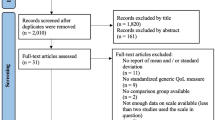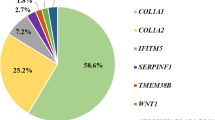Abstract
Osteogenesis imperfecta (OI) is a systemic connective tissue disorder most often caused by mutations in collagen type 1 related genes. Patients with OI suffer from multiple fractures and various degrees of growth deficiency and bone deformity. It is unknown whether the systemic effect of defect collagen type 1 influences the quality of life in patients with OI. We therefore aimed to investigate health-related quality of life (HRQoL) in a well-characterized cohort of adult patients with OI. We included 85 adult patients with mild to severe OI (types I, III, and IV) and obtained information about skeletal- and non-skeletal phenotypes and patient demographics. We investigated physical and mental HRQoL using a validated questionnaire, SF-36, and compared the data to values obtained in a population without OI. Patients with mild, moderate, and severe OI all had lower mean scores on domains describing physical HRQoL and a lower mean physical component score compared to the general population, p < 0.001. Patients with severe OI had lower mean scores on physical HRQoL, p < 0.05. The scores on domains reflecting mental HRQoL were more inhomogenously affected, but did not differ significantly from the general population. OI has an impact on physical and some aspects of mental HRQoL. The scores on physical health were correlated to severity of the OI disease. The mental component score in the OI patients was unaffected and comparable with the general population.

Similar content being viewed by others
References
Glorieux FH (2008) Osteogenesis imperfecta. Best Pract Res Clin Rheumatol 22:85–100
Sillence DO, Senn A, Danks DM (1979) Genetic heterogeneity in osteogenesis imperfecta. J Med Genet 16:101–116
Folkestad L, Hald JD, Ersboll AK, Gram J, Hermann AP, Langdahl B, Abrahamsen B (2016) Brixen K. A Nationwide Register-Based Cohort Study. J Bone Miner Res, Fracture Rates and Fracture Sites in Patients With Osteogenesis Imperfecta, p 10
van Dijk FS, Sillence DO (2014) Osteogenesis imperfecta: clinical diagnosis, nomenclature and severity assessment. Am J Med Genet A 164A:1470–1481
Chevrel G, Meunier PJ (2001) Osteogenesis imperfecta: lifelong management is imperative and feasible. Joint Bone Spine 68:125–129
Paterson CR, McAllion S, Stellman JL (1984) Osteogenesis imperfecta after the menopause. N Engl J Med 310:1694–1696
Rauch F, Glorieux FH (2004) Osteogenesis imperfecta. Lancet 363:1377–1385
Bishop NJ, Walsh JS (2014) Osteogenesis imperfecta in adults. J Clin Investig 124(2):476
Bishop N (2010) Characterising and treating osteogenesis imperfecta. Early Hum Dev 86:743–746
Balkefors V, Mattsson E, Pernow Y, Saaf M (2013) Functioning and quality of life in adults with mild-to-moderate osteogenesis imperfecta. Physiother Res Int 18:203–211
Wekre LL, Froslie KF, Haugen L, Falch JA (2010) A population-based study of demographical variables and ability to perform activities of daily living in adults with osteogenesis imperfecta. Disabil Rehabil 32:579–587
Staquet M, Hays R, Fayers P (1998) Quality of life assessment in clinical trials; methods and practice. Oxford University Press, Oxford
Widmann RF, Laplaza FJ, Bitan FD, Brooks CE, Root L (2002) Quality of life in osteogenesis imperfecta. Int Orthop 26:3–6
Forestier-Zhang L, Watts L, Turner A, Teare H, Kaye J, Barrett J, Cooper C, Eastell R, Wordsworth P, Javaid MK, Pinedo-Villanueva R (2016) Health-related quality of life and a cost-utility simulation of adults in the UK with osteogenesis imperfecta, X-linked hypophosphatemia and fibrous dysplasia. Orphanet J Rare Dis 11:160
han-Oliel N, Oliel S, Tsimicalis A, Montpetit K, Rauch F, Dogba MJ (2016) Quality of life in osteogenesis imperfecta: A mixed-methods systematic review. Am J Med Genet A 170:62–76
Widmann RF, Bitan FD, Laplaza FJ, Burke SW, DiMaio MF, Schneider R (1999) Spinal deformity, pulmonary compromise, and quality of life in osteogenesis imperfecta. Spine 24:1673–1678
Dogba MJ, Bedos C, Durigova M, Montpetit K, Wong T, Glorieux FH, Rauch F (2013) The impact of severe osteogenesis imperfecta on the lives of young patients and their parents—a qualitative analysis. BMC Pediatr 13:153. doi:10.1186/1471-2431-13-153.:153-13
Rauch F, Lalic L, Roughley P, Glorieux FH (2010) Relationship between genotype and skeletal phenotype in children and adolescents with osteogenesis imperfecta. J Bone Miner Res 25:1367–1374
Hald JD, Folkestad L, Harslof T, Lund AM, Duno M, Jensen JB, Neghabat S, Brixen K, Langdahl B (2016) Skeletal phenotypes in adult patients with osteogenesis imperfecta-correlations with COL1A1/COL1A2 genotype and collagen structure. Osteoporos Int 27(11):3331–3341
Ware JE Jr, Sherbourne CD (1992) The MOS 36-item short-form health survey (SF-36). I. conceptual framework and item selection. Med Care 30:473–483
Ware JE Jr, Kosinski M, Bayliss MS, McHorney CA, Rogers WH, Raczek A (1995) Comparison of methods for the scoring and statistical analysis of SF-36 health profile and summary measures: summary of results from the Medical Outcomes Study. Med Care 33:AS264–AS279
Bjorner JB, Thunedborg K, Kristensen TS, Modvig J, Bech P (1998) The Danish SF-36 Health Survey: translation and preliminary validity studies. J Clin Epidemiol 51:991–999
Bjorner JB, Damsgaard MT, Watt T, Groenvold M (1998) Tests of data quality, scaling assumptions, and reliability of the Danish SF-36. J Clin Epidemiol 51:1001–1011
Ablon J (2003) Personality and stereotype in osteogenesis imperfecta: behavioral phenotype or response to life’s hard challenges? Am J Med Genet A 122A:201–214
Reite M, Davis K, Solomons C, Ott J (1972) Osteogenesis imperfecta: psychological function. Am J Psychiatry 128:1540–1546
Ose D, Rochon J, Campbell SM, Wensing M, Freund T, van LJ, Langst G, Szecsenyi J, Ludt S (2014) Health-related quality of life and risk factor control: the importance of educational level in prevention of cardiovascular diseases. Eur J Public Health 24:679–684
de Putter CE, Selles RW, Haagsma JA, Polinder S, Panneman MJ, Hovius SE, Burdorf A, van Beeck EF (2014) Health-related quality of life after upper extremity injuries and predictors for suboptimal outcome. Injury 45(11):1752–1758
Peric’ S, Rakocevic-Stojanovic V, Stevic Z, Basta I, Pavlovic S, Vujanac V, Marjanovic L, Lavrnic D (2010) Health-related quality of life in patients with myotonic dystrophy type 1 and amyotrophic lateral sclerosis. Acta Neurol Belg 110:71–77
Al-Shehri AH, Taha AZ, Bahnassy AA, Salah M (2008) Health-related quality of life in type 2 diabetic patients. Ann Saudi Med 28:352–360
van der Slot WM, Nieuwenhuijsen C, van den Berg-Emons RJ, Wensink-Boonstra AE, Stam HJ, Roebroeck ME (2010) Participation and health-related quality of life in adults with spastic bilateral cerebral palsy and the role of self-efficacy. J Rehabil Med 42:528–535
Bertoletti J, Marx GC, Hattge Junior SP, Pellanda LC (2014) Quality of life and congenital heart disease in childhood and adolescence. Arq Bras Cardiol 102:192–198
Albrecht GL, Devlieger PJ (1999) The disability paradox: high quality of life against all odds. Soc Sci Med 48:977–988
Bandura A (2004) Health promotion by social cognitive means. Health Educ Behav 31:143–164
Acknowledgements
We thank Dorte Haubek and Hans Gjørup for performing dental examinations, Christer Zøylner Swan and Jens Wanscher for performing audiologic evaluations, and Christian-Heinrich Leonhard for performing eye examinations. Grant supporters: Central Region of Denmark, Osteoporoseforeningen, Denmark
Author information
Authors and Affiliations
Contributions
Author Contributions
JDH, TH, and BL designed the study. JDH conducted the study and prepared the first draft of the paper. JDH is responsible for statistical analysis of the data. All authors contributed substantially, revised the paper critically, and approved the final version of the paper. JDH is the guarantor.
Corresponding author
Ethics declarations
Conflict of interest
LF reports having received speaker fees from Genzymes and AstraZeneca. TH reports having received speaker fees from Amgen. BL reports advisory board membership and having received speaking fees from Amgen, Eli Lilly, Merck, and UCB and research support from Eli Lilly, Novo Nordisk, and Orkla Health. KB reports having received grants from MSD, Novartis, Amgen, and NPS. JDH has no interests to declare.
Human and Animal Rights and Informed Consent
The study complied with ethical standards of research involving human participants and was approved by the Danish Ethical Committee (ref-number M-20100108). Informed consent was obtained from all patients.
Rights and permissions
About this article
Cite this article
Hald, J.D., Folkestad, L., Harsløf, T. et al. Health-Related Quality of Life in Adults with Osteogenesis Imperfecta. Calcif Tissue Int 101, 473–478 (2017). https://doi.org/10.1007/s00223-017-0301-4
Received:
Accepted:
Published:
Issue Date:
DOI: https://doi.org/10.1007/s00223-017-0301-4




